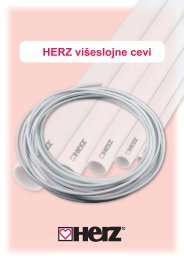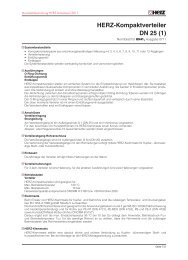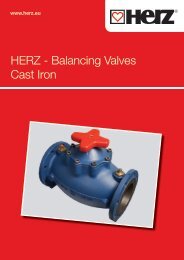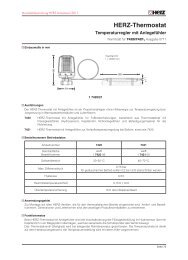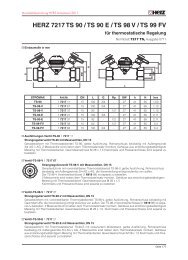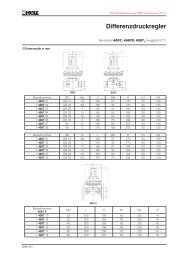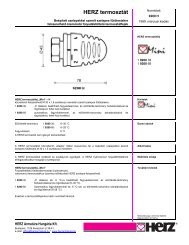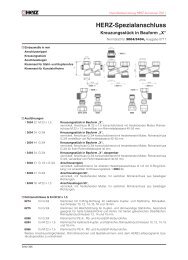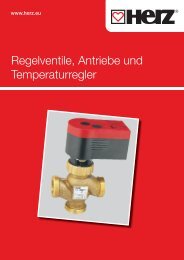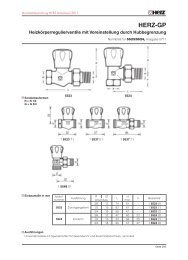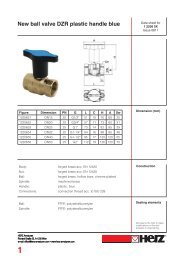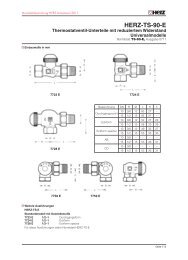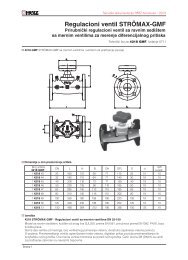HERZ laying system
HERZ laying system
HERZ laying system
Create successful ePaper yourself
Turn your PDF publications into a flip-book with our unique Google optimized e-Paper software.
Pressure tests<br />
Pressure test for floor heating according<br />
to DIN4725<br />
The piping is put under pressure and<br />
ventilated.<br />
The water pressure is to be tested directly<br />
before and after the Screed is laid.<br />
The test pressure must correspond<br />
to 1.3 times the operating pressure of<br />
the equipment and may fall by 0.2 bar<br />
maximum during the test period. The<br />
<strong>system</strong> must remain water-tight.<br />
During the <strong>laying</strong> of the screed, the<br />
pressure in the pipes must be reduced<br />
to the maximum permissible operating<br />
pressure.<br />
A pressure test of 6 bar is recommended<br />
over a period of 24 hours.<br />
Pressure test for wall heating<br />
This corresponds to a residual moisture<br />
of approximately 0.1 %. The coating test<br />
does not replace the CM measurement!<br />
The floor-layer decides whether heating<br />
of the screed is necessary. During this<br />
heating the flow temperature is increased<br />
daily in 5 °K stages. As soon as 2/3 of<br />
the heat load is achieved the screed<br />
is constantly heated for a period of<br />
approximately 2 weeks.<br />
Then the heating is sharply reduced for<br />
another 3 days. The moisture which had<br />
been forced to the bottom will then return to<br />
the top again. After this step the screed will<br />
be again heated for one week with a<br />
2/3 heat load.<br />
Before <strong>laying</strong> the top covering the<br />
temperature must be decreased.<br />
Functional heating for wall heating<br />
Wall heating with cement filler or putty may<br />
only be heated after a 21-day period.<br />
If plaster or loam has been used, the<br />
heating may only be started after 7 days.<br />
Please take note of the manufacturer’s<br />
instructions.<br />
The functional heating starts at an advance<br />
temperature of 25 °C, which should be<br />
respected for 3 days. After this period<br />
the value is increased to the maximum<br />
flow temperature, which then has to be<br />
respected for 4 days. When using wall<br />
heating with wall coverings (<strong>HERZ</strong> airconditioning<br />
<strong>system</strong>) the functional heating<br />
can be started right after the installation.<br />
The piping is put under pressure and<br />
vented. The test pressure is 1.3 times higher<br />
than the maximum operating pressure,<br />
however, at least 5 bar over pressure.<br />
A report is to be written on the density and<br />
test pressure. Then the operating pressure<br />
is set, which must then be maintained even<br />
during cleaning.<br />
- recommendation:<br />
We recommend that the piping be flushed<br />
out with warm water at least three times<br />
before the equipment is started up, in order<br />
to remove dirt or manufacturing residues<br />
from the equipment. We also recommend<br />
the installation of strainers.<br />
Drying out of screed via hot water floor<br />
heating (<strong>laying</strong> preparation)<br />
Principally the preparation for the <strong>laying</strong><br />
of screed (residual moisture) is essential<br />
before installing the floor covering.<br />
especially for the <strong>laying</strong> of wooden floors.<br />
The remaining humidity of cement screed<br />
must not exceed 1.8%. For anhydrite floors<br />
the value of 0.3%. should not be exceeded.<br />
The surface must be solid and dry. After<br />
manufacturing and corresponding <strong>laying</strong><br />
time of the screed (approximately<br />
4 weeks) as well after functional heating, the<br />
preparation for the <strong>laying</strong> of screed must<br />
be specified by means of CM measuring,<br />
which is critical for the installation of<br />
the floor covering. The drying times of<br />
the screed may vary depending on the<br />
manufacturer. Foil test: Place the PE foil<br />
approximately 50 x 50 cm on the floorfill<br />
and stick using adhesive tape. At the<br />
maximum flow temperature, it is essential<br />
that within 12 hours no condensation water<br />
is found underneath the foil. During this time<br />
the room must be ventilated.<br />
Maximum allowable moisture of the screed determined by means of a CM measuring device<br />
Floor covering Cement screed Anhydrite screed<br />
Elastic coverings 1.8 0.3<br />
Textile coverings, steam-tight 1.8 0.3<br />
Vapour permeable 3.0 1.0<br />
Parquet/cork 1.8 0.3<br />
Laminates 1.8 0.3<br />
Ceramics, natural stone, thick mortar bed 3.0 -<br />
Thin mortar bed 2.0 0.3<br />
Guide values for floor coverings glued all over the floor heating<br />
Floor covering<br />
Thickness<br />
(mm)<br />
Heat conductivity<br />
(W/(mk))<br />
Thermal resistance<br />
(m 2 K/W)<br />
Mosaic parquet (oak) 8 0.21 0.038<br />
Multi-layer parquet 11-14 0.09-0.12 0.055-0.076<br />
Strip flooring (oak) 16 0.21 0.09<br />
Laminates 9 0.17 0.044<br />
Ceramics 13 1.05 0.012<br />
Marble 12 2.1 0.0057<br />
Natural stone plate 12 1.2 0.01<br />
Concrete stone 12 2.1 0.0057<br />
Carpet - 0.07-0.17<br />
Needle felting 6.5 0.54 0.12<br />
Plastic covering 3.0 0.23 0.011<br />
PVC without support 2.0 0.20 0.010<br />
Functional heating completed<br />
Start CM measuring<br />
Readiness for the <strong>laying</strong> of<br />
screed achieved?<br />
Yes<br />
Heating for <strong>laying</strong> preparation<br />
No<br />
Laying work<br />
commenced<br />
www.herz-armaturen.com 43



